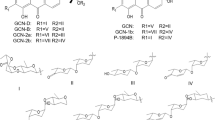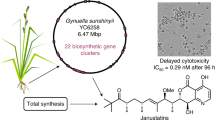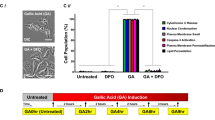Abstract
The cyanobacterial metabolite apratoxin A (1) demonstrates potent cytotoxicity against tumor cell lines by a hitherto unknown mechanism. We have used functional genomics to elucidate the molecular basis for this activity. Gene expression profiling and DNA content analysis showed that apratoxin A induces G1-phase cell cycle arrest and apoptosis. Cell-based functional assays with a genome-wide collection of expression cDNAs showed that ectopic induction of fibroblast growth factor receptor (FGFR) signaling attenuates the apoptotic activity of apratoxin A. This natural product inhibited phosphorylation and activation of STAT3, a downstream effector of FGFR signaling. It also caused defects in FGF-dependent processes during zebrafish development, with concomitant reductions in expression levels of the FGF target gene mkp3. We conclude that apratoxin A mediates its antiproliferative activity through the induction of G1 cell cycle arrest and an apoptotic cascade, which is at least partially initiated through antagonism of FGF signaling via STAT3.
This is a preview of subscription content, access via your institution
Access options
Subscribe to this journal
Receive 12 print issues and online access
$259.00 per year
only $21.58 per issue
Buy this article
- Purchase on Springer Link
- Instant access to full article PDF
Prices may be subject to local taxes which are calculated during checkout






Similar content being viewed by others
References
Newman, D.J., Cragg, G.M. & Snader, K.M. Natural products as sources of new drugs over the period 1981–2002. J. Nat. Prod. 66, 1022–1037 (2003).
Jaspars, M. & Lawton, L.A. Cyanobacteria - a novel source of pharmaceuticals. Curr. Opin. Drug Discov. Devel. 1, 77–84 (1998).
Liang, J. et al. Cryptophycins-309, 249 and other cryptophycin analogs: preclinical efficacy studies with mouse and human tumors. Invest. New Drugs 23, 213–224 (2005).
Edelman, M.J. et al. Phase 2 study of cryptophycin 52 (LY355703) in patients previously treated with platinum based chemotherapy for advanced non-small cell lung cancer. Lung Cancer 39, 197–199 (2003).
Luesch, H., Moore, R.E., Paul, V.J., Mooberry, S.L. & Corbett, T.H. Isolation of dolastatin 10 from the marine cyanobacterium Symploca species VP642 and total stereochemistry and biological evaluation of its analogue symplostatin 1. J. Nat. Prod. 64, 907–910 (2001).
Vaishampayan, U. et al. Phase II study of dolastatin-10 in patients with hormone-refractory metastatic prostate adenocarcinoma. Clin. Cancer Res. 6, 4205–4208 (2000).
Kavallaris, M., Verrills, N.M. & Hill, B.T. Anticancer therapy with novel tubulin-interacting drugs. Drug Resist. Updat. 4, 392–401 (2001).
Luesch, H., Yoshida, W.Y., Moore, R.E., Paul, V.J. & Corbett, T.H. Total structure determination of apratoxin A, a potent novel cytotoxin from the marine cyanobacterium Lyngbya majuscula. J. Am. Chem. Soc. 123, 5418–5423 (2001).
Luesch, H., Yoshida, W.Y., Moore, R.E. & Paul, V.J. New apratoxins of marine cyanobacterial origin from Guam and Palau. Bioorg. Med. Chem. 10, 1973–1978 (2002).
Chen, J. & Forsyth, C.J. Total synthesis of the marine cyanobacterial cyclodepsipeptide apratoxin A. Proc. Natl. Acad. Sci. USA 101, 12067–12072 (2004).
Paull, K.D., Hamel, E. & Malspeis, L. Prediction of biochemical mechanism of action from the in vitro antitumor screen of the National Cancer Institute. in Cancer Chemotherapeutic Agents (ed. Foye, W.O.) 9–45 (American Chemical Society Books, Washington, DC, 1995).
Beissbarth, T. & Speed, T.P. GOstat: find statistically overrepresented gene ontologies within a group of genes. Bioinformatics 20, 1464–1465 (2004).
Lauper, N. et al. Cyclin E2: a novel CDK2 partner in the late G1 and S phases of the mammalian cell cycle. Oncogene 17, 2637–2643 (1998).
Jinno, S. et al. Cdc25A is a novel phosphatase functioning early in the cell cycle. EMBO J. 13, 1549–1556 (1994).
Collavin, L., Monte, M., Verardo, R., Pfleger, C. & Schneider, C. Cell-cycle regulation of the p53-inducible gene B99. FEBS Lett. 481, 57–62 (2000).
Lum, P.Y. et al. Discovering modes of action for therapeutic compounds using a genome-wide screen of yeast heterozygotes. Cell 116, 121–137 (2004).
Giaever, G. et al. Chemogenomic profiling: identifying the functional interactions of small molecules in yeast. Proc. Natl. Acad. Sci. USA 101, 793–798 (2004).
Luesch, H. et al. A genome-wide overexpression screen in yeast for small-molecule target identification. Chem. Biol. 12, 55–63 (2005).
Choy, B.K., McClarty, G.A., Chan, A.K., Thelander, L. & Wright, J.A. Molecular mechanisms of drug resistance involving ribonucleotide reductase: hydroxyurea resistance in a series of clonally related mouse cell lines selected in the presence of increasing drug concentrations. Cancer Res. 48, 2029–2035 (1988).
Espinet, C., Gómez-Arbonés, X., Egea, J. & Comella, J.X. Combined use of the green and yellow fluorescent proteins and fluorescence-activated cell sorting to select populations of transiently transfected PC12 cells. J. Neurosci. Methods 100, 63–69 (2000).
Chambers, J.M. & Hastie, T.J. Statistical Models in S Ch. 8 (Chapman & Hall/CRC, London, 1992).
Eisen, M.B., Spellman, P.T., Brown, P.O. & Botstein, D. Cluster analysis and display of genome-wide expression patterns. Proc. Natl. Acad. Sci. USA 95, 14863–14868 (1998).
Hart, K.C. et al. Transformation and Stat activation by derivatives of FGFR1, FGFR3, and FGFR4. Oncogene 19, 3309–3320 (2000).
Yu, H. & Jove, R. The STATs of cancer – new molecular targets come of age. Nat. Rev. Cancer 4, 97–105 (2004).
Zhong, Z., Wen, Z. & Darnell, J.E., Jr. Stat3: a STAT family member activated by tyrosine phosphorylation in response to epidermal growth factor and interleukin-6. Science 264, 95–98 (1994).
Wen, Z., Zhong, Z. & Darnell, J.E., Jr. Maximal activation of transcription by Stat1 and Stat3 requires both tyrosine and serine phosphorylation. Cell 82, 241–250 (1995).
Bromberg, J.F. et al. Stat3 as an oncogene. Cell 98, 295–303 (1999).
Presta, M. et al. Fibroblast growth factor/fibroblast growth factor receptor system in angiogenesis. Cytokine Growth Factor Rev. 16, 159–178 (2005).
Xie, T. et al. Stat3 activation regulates the expression of matrix metalloproteinase-2 and tumor invasion and metastasis. Oncogene 23, 3550–3560 (2004).
Salani, D. et al. Endothelin-1 induces an angiogenic phenotype in cultured endothelial cells and stimulates neovascularization in vivo. Am. J. Pathol. 157, 1703–1711 (2000).
Dimitroff, C.J. et al. Anti-angiogenic activity of selected receptor tyrosine kinase inhibitors, PD166285 and PD173074: implications for combination treatment with photodynamic therapy. Invest. New Drugs 17, 121–135 (1999).
Martin, G.R. The roles of FGFs in the early development of vertebrate limbs. Genes Dev. 12, 1571–1586 (1998).
Capdevila, J. & Izpisúa Belmonte, J.C. Patterning mechanisms controlling vertebrate limb development. Annu. Rev. Cell Dev. Biol. 17, 87–132 (2001).
Draper, B.W., Stock, D.W. & Kimmel, C.B. Zebrafish fgf24 functions with fgf8 to promote posterior mesodermal development. Development 130, 4639–4654 (2003).
Reifers, F. et al. Fgf8 is mutated in zebrafish acerebellar (ace) mutants and is required for maintenance of midbrain-hindbrain boundary development and somitogenesis. Development 125, 2381–2395 (1998).
Fischer, S., Draper, B.W. & Neumann, C.J. The zebrafish fgf24 mutant identifies an additional level of Fgf signaling involved in vertebrate forelimb initiation. Development 130, 3515–3524 (2003).
Grandel, H., Draper, B.W. & Schulte-Merker, S. dackel acts in the ectoderm of the zebrafish pectoral fin bud to maintain AER signaling. Development 127, 4169–4178 (2000).
Kawakami, Y. et al. MKP3 mediates the cellular response to FGF8 signalling in the vertebrate limb. Nat. Cell Biol. 5, 513–519 (2003).
Tsang, M. et al. A role for MKP3 in axial patterning of the zebrafish embryo. Development 131, 2769–2779 (2004).
Mohammadi, M. et al. Structures of the tyrosine kinase domain of fibroblast growth factor receptor in complex with inhibitors. Science 276, 955–960 (1997).
Kawakami, Y. et al. Sp8 and Sp9, two closely related buttonhead-like transcription factors, regulate Fgf8 expression and limb outgrowth in vertebrate embryos. Development 131, 4763–4774 (2004).
Tomono, M., Toyoshima, K., Ito, M., Amano, H. & Kiss, Z. Inhibitors of calcineurin block expression of cyclins A and E induced by fibroblast growth factor in Swiss 3T3 fibroblasts. Arch. Biochem. Biophys. 353, 374–378 (1998).
Fuhrmann, G. et al. Cdc25A phosphatase suppresses apoptosis induced by serum deprivation. Oncogene 20, 4542–4553 (2001).
Amin, H.M. et al. Selective inhibition of STAT3 induces apoptosis and G1 cell cycle arrest in ALK-positive anaplastic large cell lymphoma. Oncogene 23, 5426–5434 (2004).
Catlett-Falcone, R. et al. Constitutive activation of Stat3 signaling confers resistance to apoptosis in human U266 myeloma cells. Immunity 10, 105–115 (1999).
Barré, B., Vigneron, A. & Coqueret, O. The STAT3 transcription factor is a target for the Myc and riboblastoma proteins on the Cdc25A promoter. J. Biol. Chem. 280, 15673–15681 (2005).
Chan, K.S. et al. Disruption of Stat3 reveals a critical role in both the initiation and the promotion stages of epithelial carcinogenesis. J. Clin. Invest. 114, 720–728 (2004).
Xi, S., Gooding, W.E. & Grandis, J.R. In vivo antitumor efficacy of STAT3 blockade using a transcription factor decoy approach: implications for cancer therapy. Oncogene 24, 970–979 (2005).
Westerfield, M. The Zebrafish Book: a Guide for the Laboratory Use of Zebrafish (Danio rerio) (Univ. of Oregon Press, Eugene, Oregon, 2000).
Hammerschmidt, M. et al. dino and mercedes, two genes regulating dorsal development in the zebrafish embryo. Development 123, 95–102 (1996).
Acknowledgements
This work was supported by the Novartis Research Foundation (to P.G.S.), the US National Institutes of Health (NIH; to J.C.I.B.), the Irving S. Sigal Postdoctoral Fellowship (to H.L.), and an Inbiomed Fellowship (to R.M.R.). We would like to thank J. Zhang and S. Ho for the sample preparation for GeneChip analysis, A. Gutierrez for technical assistance in the logistics of the cDNA screen, S. White and A. Villar for providing reporter plasmids, P. McClurg for statistical analysis, C. Trussell for assisting in the FACS analysis, G. Xia for executing the FGFR kinase assay and for providing PD173074 and G. Hampton, E. Saez, T. Murphy and A. Willingham for helpful discussions. We would like to thank Y. Kawakami and Á. Raya for their support and helpful discussions regarding the zebrafish study, and C. Rodriguez for technical assistance in obtaining the zebrafish pictures. We also thank D. Newman for providing the NCI-60 data and for running the COMPARE analysis.
Author information
Authors and Affiliations
Corresponding authors
Ethics declarations
Competing interests
The authors declare no competing financial interests.
Supplementary information
Supplementary Table 1
Activity of apratoxin A in the NCI-60 cytotoxicity assays. (PDF 33 kb)
Supplementary Table 2
Correlation of transcriptional changes induced in HT29 cells by various stress treatments and apratoxin A treatment (12 h). (PDF 60 kb)
Supplementary Table 3
cDNAs that attenuate the cytotoxicity of apratoxin A upon overexpression, grouped by their putative resistance mechanism. (PDF 31 kb)
Supplementary Table 4
Genes identified by hierarchical cluster analysis which are overexpressed in cancer cell lines most resistant to apratoxin A. (PDF 21 kb)
Rights and permissions
About this article
Cite this article
Luesch, H., Chanda, S., Raya, R. et al. A functional genomics approach to the mode of action of apratoxin A. Nat Chem Biol 2, 158–167 (2006). https://doi.org/10.1038/nchembio769
Received:
Accepted:
Published:
Issue Date:
DOI: https://doi.org/10.1038/nchembio769



